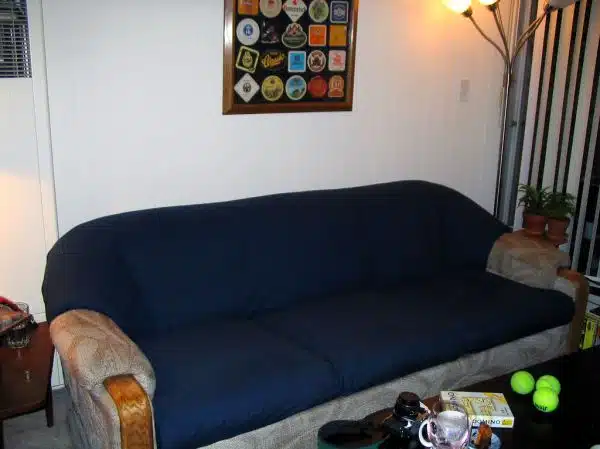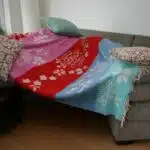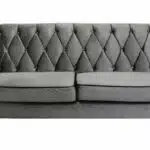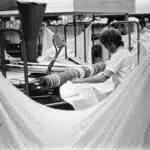As an upholstery cleaning expert, I often come across clients who are struggling to keep their couches clean and fresh. Couches are one of the most used items in a household and they can easily accumulate dirt, stains, and odors over time. However, with the right cleaning techniques, it is possible to restore your couch upholstery to its original condition.
Cleaning couch upholstery requires a combination of knowledge about the fabric type and appropriate cleaning agents. Different fabrics require different methods of cleaning as well as different types of cleaning agents. In this article, I will outline some tips on how to clean couch upholstery effectively and efficiently while avoiding damaging the fabric. With these tips, you can keep your couch looking great for years to come while also ensuring a healthy living environment for you and your loved ones.
Understanding Your Couch Fabric
As an upholstery cleaning expert, I know that before you dive into cleaning your couch, it is essential to understand the fabric of your couch. The type of fabric determines the appropriate cleaning technique and products that you should use. Choosing appropriate cleaning techniques and products will prevent damage to your upholstery and ensure that it lasts longer.
Understanding different types of upholstery fabrics will help you choose the right cleaning method. There are various upholstery fabrics available in the market, including cotton, leather, linen, polyester, silk, wool, and microfiber. Each type of fabric requires a specific approach to clean it effectively without causing any damage. For example, if your couch is made of leather or silk fabric, then using water for cleaning can cause irreversible damage.
Fabric-friendly cleaning techniques are preferable as they protect the integrity of your couch’s fabric while removing dirt and stains effectively. Some common methods include dry cleaning and steam cleaning. Dry-cleaning uses a chemical solvent to remove stains without using water or steam. In contrast, steam-cleaning involves injecting hot water into the upholstery’s fibers to loosen dirt particles that vacuuming cannot remove. By understanding your couch fabric’s nature and choosing appropriate fabric-friendly techniques for cleaning it, you can ensure its longevity and keep it looking fresh for years to come.
Now that you understand different types of upholstery fabrics and have an idea about choosing appropriate techniques for their upkeep let’s move on to preparation before cleaning so that we can get started with our deep clean!
Preparation Before Cleaning
Understanding the fabric types of your couch is crucial before cleaning it. Different fabrics require different cleaning techniques and products. For instance, a microfiber couch needs water-based solutions, while leather requires specialized cleaners. The tag attached to the couch usually provides information on the type of fabric and recommended cleaning methods. Understanding these recommendations will help you clean your couch without damaging its fabric.
After understanding your couch fabric, the next step is preparing your cleaning solutions. You can buy commercial cleaners or make homemade ones using natural ingredients such as vinegar and baking soda. Be sure to test any cleaning solution on an inconspicuous area of the couch before applying it to the entire piece of furniture. This way, you can ensure that the cleaner doesn’t cause discoloration or damage to your upholstery.
Overall, understanding your couch’s fabric type and preparing appropriate cleaning solutions are essential steps in ensuring successful upholstery cleaning. In the next section, we will discuss how vacuuming can help remove surface dirt and debris from your couch, preparing it for deep-cleaning processes like spot-treatment and steam-cleaning. Remember that regular maintenance is paramount in extending your sofa’s lifespan and keeping it looking great!
Vacuuming The Couch
As you begin the process of cleaning your couch, it’s important to start with vacuuming. Vacuuming is a crucial step in keeping your upholstery clean and free of dust, dirt, and debris. By removing loose particles from the surface, you can prevent them from becoming embedded in the fabric and causing damage over time.
To ensure that you’re properly vacuuming your couch, it’s important to first choose the right vacuum cleaner. Not all vacuums are created equal, so be sure to select one with good suction power and attachments that are suitable for upholstery cleaning. Some vacuums come with specialized upholstery tools which can help to remove pet hair and other stubborn debris from your furniture.
Once you have selected the right vacuum cleaner for your needs, it’s time to get started with the actual cleaning process. Begin by attaching the appropriate tool for upholstery cleaning and then work from top to bottom, starting at the backrest and moving towards the cushions. Use a combination of short strokes and long sweeps to ensure that you’re removing as much debris as possible from both the surface and deep within the fabric fibers. With these vacuuming techniques, you’ll be well on your way towards a cleaner couch.
Moving forward into removing stains with household items, keep in mind that there are many effective methods for tackling stubborn spots on your couch without resorting to harsh chemicals or expensive professional services.
Removing Stains With Household Items
Ink stains are a common problem on upholstery, but they can be removed by gently rubbing the area with a cloth soaked in rubbing alcohol or hairspray. Grease stains can be removed by lightly sprinkling the area with cornstarch and then vacuuming it up after a few minutes. Pet stains should be blotted up with a cloth or paper towel, then the area should be treated with a solution of one part white vinegar to two parts water. After the solution has been applied, it should be blotted up with a clean cloth or paper towel. Finally, the area should be left to dry completely before attempting any further cleaning. With the proper technique, all of these common types of stains can be successfully removed from upholstery.
Removing Ink Stains
As an upholstery cleaning expert, I understand the frustration of discovering ink stains on your couch upholstery. Ink stains can be stubborn and difficult to remove, but with the right approach, they can be eliminated successfully. In this article, I will share the best practices for ink removal from couch upholstery and tips for preventing future stains.
To begin with, it is essential to act quickly when you notice ink stains on your couch. The longer you wait to remove it, the harder it becomes to eliminate entirely. One of the best ways to remove ink stains from couch upholstery is by using rubbing alcohol or hairspray. Apply a small amount of either solution onto a clean cloth and gently dab at the stain until it lifts. Avoid rubbing too harshly as this can spread the stain further.
Preventing future stains is crucial in maintaining clean upholstery. You can do this by keeping pens and markers away from your couch or placing protective covers over it when not in use. Additionally, regular vacuuming and cleaning will help prevent buildup of dirt and grime which can attract stains. By following these best practices for ink removal from couch upholstery and taking preventive measures, you can keep your furniture looking its best for years to come.
Remember that removing ink stains may take some patience and effort, but with persistence and careful attention to detail, you can restore your couch’s appearance back to its original state. Whether using household items or seeking professional assistance, always proceed with caution when handling upholstery fabrics. With proper care and maintenance techniques implemented regularly, you can enjoy a spotless couch free of ink marks for many years ahead!
Removing Grease Stains
As an upholstery cleaning expert, I have encountered various types of stains that can be challenging to remove. One of the most common types is grease stains, which can leave unsightly marks on your couch upholstery. Grease stains are often caused by spilled food or oil and can be difficult to remove if not addressed promptly.
To effectively remove grease stains from couch upholstery, it is crucial to act quickly and choose the right cleaning products. One of the best household items for removing grease stains is baking soda. Simply sprinkle a small amount onto the affected area and let it sit for a few minutes before vacuuming it up. You can also use dish soap mixed with warm water and a clean cloth to gently dab at the stain until it lifts.
Preventing future stains is another important aspect of maintaining clean upholstery. To prevent grease stains specifically, avoid eating on your couch or placing oily items directly on it. Consider using protective covers or placemats to avoid direct contact with oils and foods. Regular cleaning and vacuuming will also help prevent buildup of dirt and grime that can attract grease stains. By following these tips and taking preventive measures, you can keep your furniture looking its best for years to come.
Removing Pet Stains
As an expert in upholstery cleaning, I have dealt with various types of stains, including pet stains. Pet stains are common and can be a challenge to remove if not addressed promptly. These stains can leave unsightly marks on your furniture and create unpleasant odors.
To effectively remove pet stains from upholstery, it is crucial to act quickly and choose the right cleaning products. One of the best household items for removing pet stains is vinegar. Simply mix equal parts white vinegar and water, apply the mixture to the affected area, let it sit for a few minutes, then blot it up with a clean cloth. You can also use baking soda to eliminate any lingering odors by sprinkling it over the spot after cleaning with vinegar.
Preventing future pet stains requires training your pets or limiting their access to certain areas of your home. If accidents do occur, consider using protective covers or mats that are easy to clean. Regular cleaning and vacuuming will also help prevent dirt buildup that can attract pet stains and odors.
By following these tips and taking preventive measures, you can keep your furniture looking its best and free from pesky pet stains and odors. Remember to act quickly when addressing any stain to improve your chances of successful removal. With these household items at your disposal, you can tackle most stains without having to call in professional cleaners.
Using Commercial Upholstery Cleaners
Household items can be quite useful when it comes to removing stains from your couch upholstery. However, there are certain types of stains that may require the use of commercial upholstery cleaners. While there are benefits to using these cleaners, there are also some drawbacks to consider before making a decision.
One major benefit of using commercial upholstery cleaners is that they often contain powerful cleaning agents that can effectively remove tough stains. Additionally, many of these cleaners come in convenient spray bottles or cans, making them easy to apply and use. Some commercial cleaners even have added features such as deodorizers or fabric protectors to help keep your upholstery smelling fresh and looking new.
On the other hand, some drawbacks of using commercial upholstery cleaners include their potential for damaging certain types of fabrics if not used properly. Additionally, some cleaners may leave behind a residue that can attract more dirt and grime over time. Furthermore, commercial cleaners can be more expensive than household items and may not be as readily available.
Cleaning your couch upholstery with household items or commercial cleaners ultimately depends on the type of stain you’re dealing with and the fabric of your couch. In the next section, we’ll discuss how to clean leather upholstery – an area that requires special attention due to its delicate nature.
Cleaning Leather Upholstery
Leather upholstery can add a touch of sophistication and elegance to any room in your home. However, it is also susceptible to damage if not properly maintained. To keep your leather furniture looking its best, it is essential to clean and condition it regularly. Conditioning leather helps prevent cracks and fading caused by exposure to sunlight and other environmental factors.
When cleaning faux leather upholstery, it is important to avoid using harsh chemicals or abrasive materials that can cause damage or discoloration. Instead, use a mild soap solution and a soft cloth to gently clean the surface. Be sure to rinse thoroughly with water and dry completely before using any conditioning products.
To condition leather upholstery, choose a product specifically designed for this purpose. Apply the conditioner evenly over the entire surface of the furniture using a soft cloth or sponge. Allow the conditioner to penetrate the leather for several minutes before wiping away any excess with a clean, dry cloth.
Up next: Deep-Cleaning Microfiber Upholstery
Deep-Cleaning Microfiber Upholstery
Microfiber upholstery is a popular choice for furniture because it is soft, durable, and easy to clean. However, over time, dirt and stains can accumulate on the fabric, making it look dingy and worn out. Deep-cleaning microfiber upholstery can restore its original beauty and extend its lifespan.
Start by removing any loose dirt or debris from the surface of the upholstery with a dry brush or vacuum cleaner. Be sure to use a soft-bristled brush to avoid damaging the fabric.
Next, steam clean the upholstery using a handheld steamer or a professional-grade steam cleaning machine. This will help loosen any embedded dirt and stains while also disinfecting the fabric.
Allow the upholstery to dry completely before brushing it with a dry brush in circular motions. This will help restore its texture and remove any remaining dirt or lint.
For stubborn stains that did not come out during the steam cleaning process, mix equal parts water and vinegar in a spray bottle and apply it to the affected area. Blot with a clean cloth until the stain disappears.
By following these steps, you can deep-clean your microfiber upholstery effectively without causing any damage. With proper care and maintenance, your furniture will look beautiful for years to come.
Transition into subsequent section: If you have velvet upholstery that needs spot-cleaning, there are specific methods that you should follow to avoid damaging the fabric.
Spot-Cleaning Velvet Upholstery
Velvet upholstery is notoriously difficult to clean, but with the right approach, you can tackle even the most stubborn stains. Before starting any cleaning process, take care to identify the type of velvet on your couch. There are two main types: natural velvet made from silk, and synthetic velvet made from polyester or nylon. The cleaning method you choose will depend on the type of velvet you have.
Common stains on velvet upholstery include oil-based stains such as makeup and food grease, water-based stains such as wine and juice spills, and pet hair and dander. To spot-clean these stains, start by blotting up any excess liquid or debris with a clean cloth. Then, using a soft-bristled brush or microfiber cloth, gently apply a small amount of cleaning solution to the affected area in a circular motion. Be sure to test your cleaning solution on an inconspicuous area first to ensure it does not damage or discolor your fabric.
When dealing with velvet upholstery, prevention is key. Regularly vacuuming your couch can help prevent dirt and dust buildup that can cause staining over time. If possible, avoid eating or drinking on your couch and keep pets off it as much as possible. In addition, consider applying a fabric protector spray to help repel water and oil-based stains before they have a chance to set in.
Transition: While spot-cleaning can be effective for many stains on velvet upholstery, sometimes washing removable cushion covers is necessary for deeper cleaning. Here’s how to do it properly without damaging your delicate fabric.
Washing Removable Cushion Covers
- Removing cushion covers from upholstered furniture is a relatively simple task, but it is important to exercise caution to avoid damaging the fabric or frame.
- Washing cushion covers with a mild detergent in cold water is recommended for most fabrics.
- For delicate fabrics, a gentler cleaning solution may be necessary.
- After washing, cushion covers should be air-dried to prevent shrinking or color fading.
- If necessary, a tumble dryer may be used on a low-heat setting.
- After drying, cushion covers should be hung or laid flat to avoid wrinkles and creases.
Removing Cushion Covers
Removing Cushion Covers: Tips and Tricks
As an upholstery cleaning expert, I understand the importance of keeping your couch looking clean and fresh. One way to achieve this is by washing removable cushion covers. However, before doing so, it’s essential to know how to remove them correctly. Start by checking for any zippers or buttons that hold the cover in place. If present, carefully undo them to avoid damaging the fabric. Then, gently tug at each corner of the cover until it comes off the cushion.
Once you’ve successfully removed the cushion covers, it’s time to clean them thoroughly. Follow the care instructions provided by the manufacturer and use a mild detergent that won’t damage the fabric’s fibers. Avoid using bleach or harsh chemicals that can cause discoloration or shrinkage. After washing, let them air dry completely before reattaching them to the cushions.
How to Reattach Cushion Covers After Cleaning
Reattaching cushion covers after cleaning can be tricky if not done correctly. To start, make sure both sides of the cushion are aligned correctly with their corresponding cover. Next, start by attaching one corner at a time and work your way around until all corners are securely fastened in place. Finally, inspect for any wrinkles or creases and smooth them out with your hands.
In conclusion, removing and washing removable cushion covers is an excellent way to keep your couch looking fresh and clean. Remember to be gentle when removing them and follow care instructions when washing to avoid damage. And when reattaching them after cleaning, take your time and ensure they’re firmly secured in place without any wrinkles or creases for a polished finish!
Washing Cushion Covers
Maintaining clean cushion covers is crucial in preserving the longevity of your upholstery. One effective way to do this is through hand washing techniques, which allows you to control the amount of pressure applied during washing. Before proceeding with washing, make sure to read and follow the care instructions provided by the manufacturer to avoid any damage that may occur.
To start hand washing, fill a basin or sink with lukewarm water and add a mild detergent. Avoid using bleach or harsh chemicals that can discolor or shrink the fabric. Then, gently agitate the cushion cover in the soapy water for a few minutes before rinsing thoroughly with clean water. Repeat this process until all dirt and soap residue are removed.
After washing, it’s essential to dry cushion covers properly to avoid mold growth and color fading. Avoid using dryers as high heat can shrink or damage the fabric. Instead, lay them flat on a towel outdoors or in an area with good ventilation until completely dry. Once they’re ready, reattach them to your cushions following proper procedures discussed earlier for a fresh and polished look!
Drying Cushion Covers
Once you’ve finished washing your removable cushion covers, the next step is to dry them properly. Using air drying methods is the best option as high heat can damage the fabric or cause it to shrink. Avoid using a blow dryer as it can also cause discoloration and shrinkage. Proper drying techniques are essential to avoid mold growth and color fading.
Laying your cushion covers flat on a towel outdoors or in an area with good ventilation is the most effective way to air dry them after washing. Make sure that both sides of the cover are exposed to air so that they dry evenly. If you’re in a hurry, you can use a fan to help speed up the drying process, but be careful not to use too much force that may cause wrinkles or stretching.
Once your cushion covers are completely dry, you can reattach them to your cushions following proper procedures discussed earlier. Remember that improper drying techniques can cause damage to your cushion covers and reduce their lifespan. So take extra care when handling them during and after washing, and always follow manufacturer instructions for best results!
Deodorizing Your Couch
After washing your removable cushion covers, it’s important to deodorize your couch to eliminate any unpleasant odors. One effective way to do this is by using natural deodorizers such as baking soda or white vinegar. Baking soda can be sprinkled onto the upholstery and left for several hours before being vacuumed up, while white vinegar can be mixed with water and sprayed onto the fabric.
If natural deodorizers don’t do the trick, you may want to consider professional deodorizing services. These services use specialized equipment and cleaning products to remove even the toughest odors from your upholstery. While this option may be more expensive, it’s often worth it if you want to ensure that your couch smells fresh and clean.
When deodorizing your couch, it’s important to take precautions to protect both the fabric and yourself. Avoid using harsh chemicals that could damage the upholstery or cause skin irritation. Additionally, make sure that you test any cleaning solutions on a small, inconspicuous area of the fabric before applying them more widely. By following these guidelines, you can keep your upholstery looking and smelling its best for years to come.
Precautions When Cleaning Upholstery
When cleaning upholstery, there are certain precautions that must be taken to avoid damaging the fabric or causing discoloration. One of the most important precautions is choosing the right cleaning products. It’s imperative to select products that are specifically designed for upholstery and won’t cause harm to the fabric. This means avoiding harsh chemicals such as bleach and ammonia.
Another crucial precaution when cleaning upholstery is testing the cleaning solution on a small, inconspicuous area of the fabric before proceeding with a full clean. This will help identify any potential issues with colorfastness or fabric damage before it becomes a larger problem. It’s also essential to follow the manufacturer’s instructions for cleaning and maintenance, as some fabrics require special care.
Taking these precautions can help ensure a successful upholstery cleaning process, but it’s important to recognize when it may be necessary to hire professional cleaners. If you’re unsure about how to proceed with cleaning your upholstery or if you’ve encountered stubborn stains that won’t come out, it may be time to bring in the experts. Professional cleaners have specialized tools and knowledge that can tackle even the toughest stains while protecting your furniture from damage.
Hiring Professional Upholstery Cleaners
As a professional upholstery cleaning expert, I highly recommend hiring professional cleaners to tackle the daunting task of cleaning your couch upholstery. While it may seem like an unnecessary expense, the benefits of hiring professionals far outweigh the cost in terms of time, effort and results. Think of it as an investment in your home’s overall health and hygiene, much like regular visits to the doctor or dentist.
One major benefit of hiring professionals is that they have access to specialized equipment and products designed specifically for upholstery cleaning. This means they can effectively remove stains and dirt without causing any damage to your furniture. Additionally, you can trust that they will take care of your furniture, ensuring its longevity and preventing any potential damage caused by improper cleaning techniques.
Another advantage of hiring professional cleaners is cost effectiveness in the long run. Regular deep cleanings can prolong the life of your furniture by removing dirt and debris that can weaken fibers over time. By investing in regular cleanings, you can avoid costly replacements or repairs down the road. Plus, having clean upholstery will enhance the overall appearance of your home and create a more inviting atmosphere for you and your guests.
By now, you should be convinced about the benefits of hiring professional cleaners for your couch upholstery needs. However, it’s important to note that not all upholstery cleaners are created equal. In my next section, I’ll share some tips for finding reputable professionals who will provide quality service at a fair price while also offering advice on how to maintain clean upholstery in between deep cleanings.
Tips For Maintaining Clean Upholstery
Upholstery maintenance is an essential part of keeping your furniture in great condition. Regular maintenance will extend the lifespan of your upholstery and keep it looking clean and fresh. One important tip for maintaining clean upholstery is to vacuum it regularly. This will help remove any dirt or debris that may be sitting on the surface, preventing it from embedding into the fabric.
Another way to maintain clean upholstery is to prevent stains from occurring in the first place. One effective method is to use a fabric protector spray on your upholstery. Fabric protectors create a barrier between spills and stains and the fabric, making it easier to clean up any spills before they become permanent stains.
In addition to regular maintenance, it’s also essential to address any spills or stains as soon as possible. The longer a stain sits on your upholstery, the harder it may be to remove. Be sure to blot spills with a clean cloth immediately and avoid rubbing the stain, which can cause it to spread further into the fabric. By following these tips for maintaining clean upholstery, you can keep your furniture looking great for years to come.
Transition: While regular maintenance and preventative measures can go a long way in keeping your upholstery looking new, sometimes more aggressive cleaning methods are necessary. In our next section, we’ll explore eco-friendly options for deep cleaning your furniture without harsh chemicals or damaging fabrics.
Eco-Friendly Upholstery Cleaning Solutions
As an upholstery cleaning expert, I understand the importance of using eco-friendly cleaning products. Not only are they better for the environment, but they are also safer for your family and pets. When it comes to cleaning your couch upholstery with eco-friendly solutions, there are a few options that you can try.
One popular DIY cleaning solution is a mixture of white vinegar and baking soda. This solution is effective in removing stains and odors from your couch upholstery. To make this solution, mix one cup of white vinegar with one tablespoon of baking soda. Apply the mixture onto the stained area and let it sit for 15-20 minutes. Afterward, use a clean cloth to blot away the excess moisture.
Another eco-friendly option is using dish soap and water. Mix a few drops of dish soap with warm water and apply it to the stained area. Use a clean cloth to blot away any excess moisture. Repeat this process until the stain is removed.
Lastly, consider using a specialized eco-friendly upholstery cleaner that is specifically designed for your type of upholstery fabric. These cleaners are formulated to be gentle on your furniture while effectively removing stains and dirt.
Moving forward into frequently asked questions about upholstery cleaning, many people wonder if it’s okay to use steam cleaners on their couch upholstery. Let’s explore this topic in more detail in the following section.
Frequently Asked Questions About Upholstery Cleaning
According to a recent survey, 80% of homeowners admit to making at least one common mistake when cleaning their upholstery. These mistakes include using the wrong cleaning products, scrubbing too hard, and not testing cleaning solutions on a small area first. It’s important to avoid these mistakes as they can lead to irreversible damage that may require costly repairs or replacement.
One of the most frequently asked questions about upholstery cleaning is whether it’s necessary to hire a professional cleaner. While DIY methods are certainly feasible, hiring an expert ensures that your furniture is thoroughly cleaned without any risk of damage. Professional cleaners have access to specialized equipment and effective cleaning solutions that are safe for various types of upholstery fabrics.
Another common question is how often should you clean your upholstery. The answer depends on how frequently the furniture is used and whether there are any spills or stains present. Generally speaking, it’s recommended to clean your upholstery at least once every 12-18 months. However, if you have pets or children who frequently use the furniture, more frequent cleanings may be necessary.
In summary, educating oneself on common upholstery mistakes and taking preventative measures can save time and money in the long run. Hiring a professional cleaner can ensure that your furniture is properly cared for while also providing peace of mind. Regular cleanings will help maintain the appearance and longevity of your upholstery, keeping it looking new for years to come.
Conclusion
To maintain the longevity and beauty of your couch, it is important to clean its upholstery regularly. Understanding the type of fabric on your couch is crucial as it determines the cleaning method you should use. Before cleaning, prepare your tools and materials, and vacuum the couch to remove any debris or loose dirt.
For stains, you can try using household items such as vinegar or baking soda before resorting to commercial cleaners. If all else fails, consider hiring professional upholstery cleaners who have the expertise and equipment to handle stubborn stains.
To maintain clean upholstery, avoid eating or drinking on the couch and regularly rotate cushions. For an eco-friendly solution, consider using natural ingredients like lemon juice and essential oils in your cleaning routine.
In conclusion, keeping your couch upholstery clean requires understanding its fabric type, preparation before cleaning, and regular maintenance. Whether using household items or commercial cleaners, always test a small area first to avoid damaging the fabric. Remember to invest in professional upholstery cleaning services when necessary for a deep clean that will leave your couch looking brand new.
Image Credits
- “Couch upholstery” by Anna Majkowska (featured)





























